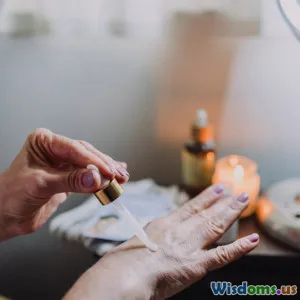
How to Build a Morning Routine for Oily Skin
9 min read Master a tailored morning routine to manage oily skin effectively, balancing hydration and oil control for a radiant, fresh complexion. (0 Reviews)
How to Build a Morning Routine for Oily Skin
Oily skin, characterized by excess sebum production, can feel like a double-edged sword: it naturally hydrates and protects your skin but often brings unwanted shine, clogged pores, and the threat of acne. Yet, crafting a morning routine tailored specifically for oily skin can transform your complexion, minimize breakouts, and bolster your confidence. This guide dives deep into how to build an effective, science-backed morning routine to keep oily skin balanced and fresh.
Understanding Oily Skin: The Foundation of Your Routine
The first step to designing an efficient skincare routine starts with the understanding of your skin’s nature. Oily skin typically exhibits visible pores and tends to shine by midday due to the overactive sebaceous glands. According to a 2018 study published in the Journal of Clinical and Aesthetic Dermatology, sebum overproduction is influenced by genetics, hormonal fluctuations, diet, and environmental factors.
Key Characteristics of Oily Skin:
- Excessive shine, especially on the forehead, nose, and chin (T-zone)
- Enlarged pores
- Prone to acne and blackheads
- Makeup tends to wear off faster due to oil
It's essential to resist the urge to 'dry out' oily skin aggressively. Over-washing or harsh products strip natural oils, triggering even more sebum production as a biological response. Therefore, an effective routine respects your skin’s balance.
Step 1: Choose the Right Cleanser
Morning cleansing is vital to remove sweat, excess oil, and residual nighttime products that can clog pores. For oily skin, your cleanser should:
- Be gentle yet effective at removing impurities
- Control oil production without stripping moisture
Recommended Types:
- Gel-based or foaming cleansers: Targets excess sebum and keeps skin matte without harshness.
- Salicylic acid cleansers: This beta hydroxy acid penetrates pores and exfoliates dead skin cells, reducing blackheads and acne. A 2017 Clinical, Cosmetic and Investigational Dermatology review confirmed salicylic acid's safety and efficacy in oily skin care.
Example: CeraVe Foaming Facial Cleanser contains ceramides and niacinamide, balancing cleansing with soothing properties.
How to Use:
- Wet face with lukewarm water.
- Apply a dime-sized amount of cleanser.
- Massage gently in circular motions for 30-45 seconds.
- Rinse thoroughly and pat dry with a soft towel.
Remember that over-washing (more than twice daily) may exacerbate oiliness as the skin attempts to rehydrate itself.
Step 2: Apply a Balancing Toner
Toning helps restore skin pH and tightens pores. For oily skin, toners that provide light hydration without alcohol or irritants are ideal.
Key Ingredients to Look For:
- Niacinamide: Reduces sebum production and inflammation. A 2019 study in Dermatology Research and Practice revealed niacinamide’s significant oil-regulating effect.
- Witch hazel: A natural astringent that controls oiliness without drying excessively.
- Green tea extract: Contains antioxidants and anti-inflammatory agents beneficial for acne-prone skin.
Avoid: Toners with high alcohol content, fragrances, or harsh astringents as they can dry out skin and trigger more oil.
Example: Thayers Witch Hazel Toner (Alcohol-free) with aloe vera or The Ordinary Glycolic Acid Toner for chemical exfoliation (use cautiously).
How to Use:
- Apply toner on a cotton pad or palms.
- Gently press onto the face, focusing on the T-zone.
- Allow skin to absorb before moving to the next step.
Step 3: Hydrate With a Lightweight Moisturizer
A common misconception is that oily skin doesn’t need moisturizing. On the contrary, hydration is essential to maintain a healthy skin barrier and prevent excess oil overproduction.
Characteristics of Ideal Moisturizers for Oily Skin:
- Oil-free, non-comedogenic formulations
- Lightweight gel or water-based textures
- Ingredients such as hyaluronic acid that attract moisture without heaviness
Examples:
- Neutrogena Hydro Boost Water Gel
- La Roche-Posay Effaclar Mat Moisturizer
Scientific Insight: Hyaluronic acid retains moisture without adding oil, enhancing skin elasticity as per a 2019 review in the International Journal of Molecular Sciences.
How to Use:
- Take a pea-sized amount.
- Warm between hands and apply evenly across face.
- Pat gently till absorbed.
Step 4: Use Sunscreen Every Morning
Sun protection is critical regardless of skin type. Oily skin, however, requires sunscreens that do not exacerbate shine or cause breakouts.
Ideal Sunscreens for Oily Skin:
- Mattifying or oil-free formulas
- Mineral-based ingredients like zinc oxide or titanium dioxide
- Non-comedogenic and lightweight
Why It Matters:
According to the American Academy of Dermatology, broad-spectrum SPF 30+ sunscreen prevents sun damage, which can lead to hyperpigmentation and premature aging even in oily skin.
Examples:
- EltaMD UV Clear Broad-Spectrum SPF 46
- La Roche-Posay Anthelios Clear Skin Dry Touch Sunscreen SPF 60
Application Tips:
- Apply at least a nickel-sized amount
- Don’t forget the ears, neck, and hairline
- Reapply if you spend extensive time outdoors
Additional Tips to Enhance Your Morning Routine
1. Incorporate Exfoliation 2-3 Times Weekly
For oily skin, removing dead skin cells helps prevent clogged pores and shine.
Best Exfoliants: Chemical exfoliants like salicylic acid or glycolic acid rather than harsh physical scrubs, which may irritate and trigger more oil.
2. Control Oil Throughout the Day
Using blotting papers or mattifying primers can keep your skin shine-free. These should not replace morning cleansing routines.
3. Mind Your Diet and Lifestyle
Research published in Dermato-Endocrinology suggests diets high in refined sugars and dairy can exacerbate oily skin and acne. Hydrating and eating antioxidant-rich foods supports skin health.
4. Avoid Overloading with Products
A minimalist and consistent regimen is more effective than layering too many products, which can overwhelm skin and increase oil.
Real-World Success Stories
Many individuals have reported positive transformations after adopting a balanced routine. For instance, Sarah J., a 28-year-old teacher, shared on a skincare forum:
"Switching to a gentle salicylic acid cleanser and adding niacinamide toner truly transformed my greasy skin to a more balanced glow within just weeks. Sunscreen was a game-changer for preventing post-acne marks."
Such real testimonials support the notion that consistency combined with the right products tailored to oily skin yields remarkable results.
Conclusion
Building a morning routine for oily skin doesn’t mean waging a war against your unique complexion. It involves understanding your skin's behavior and selecting products that gently cleanse, tone, hydrate, and protect without triggering excess oil production. By following the steps outlined—from choosing a gentle cleanser with salicylic acid to applying oil-free moisturizer and a mattifying sunscreen—you empower your skin to look its best daylight hours.
Remember, success depends on consistency and attentiveness to your skin’s responses. Consult a dermatologist for personalized advice, especially if acne persists. Embrace your morning ritual as a form of self-care and watch your oily skin transform into your best asset.
References:
- Draelos ZD. Cosmetics and Dermatologic Therapy, 2018.
- Clinical, Cosmetic and Investigational Dermatology, 2017.
- Dermatology Research and Practice, 2019.
- International Journal of Molecular Sciences, 2019.
- American Academy of Dermatology Association.
- Dermato-Endocrinology Journal.
Start today, and make your morning routine a vital step toward healthy, balanced oily skin.
Rate the Post
User Reviews
Popular Posts



















